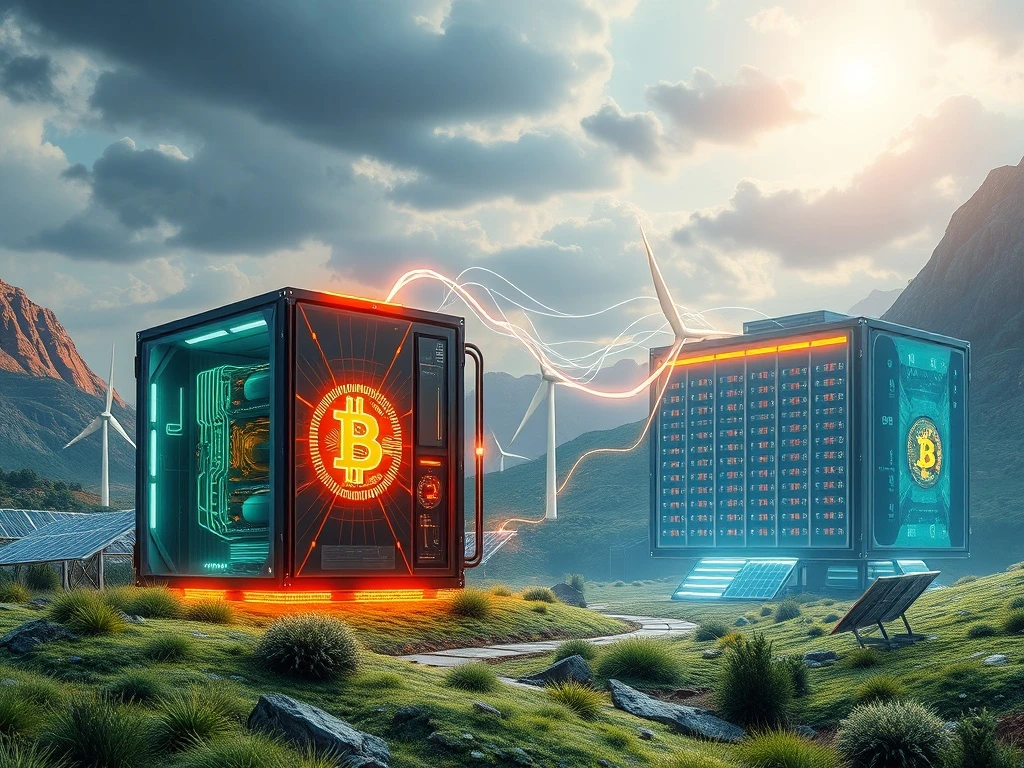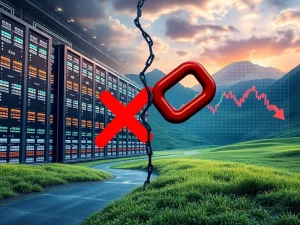Bitcoin Mining Energy: Unveiling the Crucial Battle with AI Data Centers

The cryptocurrency landscape constantly evolves. Currently, a significant development reshapes the very foundation of Bitcoin mining. An intense competition for energy is underway. Bitcoin mining energy, traditionally focused on securing cheap power, now faces a formidable challenger. This challenger comes in the form of rapidly expanding artificial intelligence (AI) data centers. This escalating rivalry could redefine investment flows. It may also alter operational strategies within the broader crypto sector. Furthermore, it highlights a critical pivot towards sustainable power sources for both burgeoning industries.
Bitcoin Mining Energy: The Escalating Demand
Bitcoin mining operations fundamentally rely on vast amounts of electricity. Miners meticulously seek the lowest possible energy costs. This helps them maintain profitability. This pursuit becomes especially critical after events like the Bitcoin halving. Such events significantly reduce block rewards. Historically, this search for affordable power led miners to diverse regions. They often targeted areas with abundant and sometimes stranded power. For example, hydro-rich locations or places with excess natural gas lacked other economic outlets. However, the global energy landscape is shifting dramatically. The increasing computational demands of AI, particularly for training large language models and advanced algorithms, create an unprecedented hunger for energy. This convergence of two high-energy industries now places immense pressure on existing power grids. It also strains available sustainable sources. Consequently, the competition for affordable, reliable power intensifies daily. This impacts the strategic decisions of both miners and tech giants.
Moreover, the sheer scale of energy consumption by both sectors is staggering. Bitcoin mining alone consumes gigawatts of power globally. Similarly, AI data centers require immense and continuous energy supplies. They power complex servers and cooling systems. This dual demand strains local grids and global energy markets. Therefore, companies in both fields actively seek new and innovative energy solutions. This intense pursuit drives innovation in renewable energy infrastructure. It also encourages the development of more efficient hardware for both mining and AI computations. Ultimately, the future growth of both industries hinges on securing sustainable and cost-effective energy access.
The AI Data Centers’ Power Play
AI data centers represent a powerful new force in the energy market. These facilities, often backed by tech giants with deep capital reserves, require consistent, high-speed power. Their operational needs differ slightly from Bitcoin miners. Yet, both industries converge on the fundamental need for cheap and sustainable energy. Jeremy Dreier, managing director and chief business development officer at GoMining Institutional, highlights this emerging dynamic. He notes that AI data centers are increasingly outbidding miners for crucial power infrastructure. This trend suggests a potential “pricing out” of some Bitcoin miners. In some cases, miners might even deprioritize their core mining activities. This occurs due to these significant market pressures. This shift reflects the immense financial backing and strategic imperative behind AI development.
Furthermore, the long-term contracts and substantial upfront investments characteristic of AI data centers give them a competitive edge. They can often secure better rates and more stable power supplies. This happens more easily than some independent Bitcoin mining operations. However, Bitcoin miners possess a unique advantage: flexibility. They can expand into more off-grid locations. These areas often lack the high-speed internet infrastructure essential for AI facilities. This adaptability allows miners to tap into otherwise unutilized or stranded energy sources. Therefore, while AI firms dominate established grid connections, miners can carve out niches. These niches exist in remote, energy-rich environments. This strategic agility becomes a critical differentiator in the ongoing energy competition.
Institutional Crypto Investment: A New Frontier
Despite the rising competition for energy, this battle could paradoxically trigger a significant surge in institutional crypto investment. Dreier predicts a “new heyday” for Bitcoin mining over the next five to ten years. This renewed interest stems directly from the ongoing energy competition. It also arises from the increasing maturity of the crypto market. Institutional capital already flows into US spot Bitcoin exchange-traded funds (ETFs). Now, it views mining investments as a logical progression. Investors increasingly seek diversified exposure within the crypto ecosystem. Mining operations, therefore, present a compelling opportunity for these large-scale investors. They can gain direct exposure to Bitcoin production. This is potentially at a lower cost basis than market purchases.
Moreover, the increasing demand for Bitcoin from traditional finance institutions creates a need for new supply avenues. Investing in mining operations allows institutions to participate directly in the supply side of the Bitcoin economy. This participation offers a strategic advantage. It goes beyond simply holding spot BTC. It provides a means to influence supply dynamics. It can also potentially achieve a more favorable entry point. Consequently, this shift represents a maturation of the institutional approach to crypto. It moves beyond simple asset allocation. Instead, it embraces direct participation in the underlying infrastructure that supports the digital asset ecosystem.
The Allure of Virgin Bitcoin
A key driver for this anticipated institutional crypto investment surge is the desire for “virgin” Bitcoin. Institutions increasingly want to acquire newly minted Bitcoins. This strategy allows them to obtain BTC cheaper. This is compared to purchasing at prevailing spot market prices. Dreier emphasizes this point. He notes that many institutions inquire about Bitcoin mining infrastructure services from GoMining. They aim to secure a more cost-effective way to add Bitcoin to their balance sheets. This approach offers a distinct advantage over buying large quantities on exchanges. Such large market orders can sometimes lead to price slippage or higher transaction costs. Acquiring virgin Bitcoin directly from mining operations offers a unique value proposition. This applies to large-scale corporate treasuries and investment funds.
Consider the benefits for institutions pursuing virgin Bitcoin:
- Cost Efficiency: Acquiring Bitcoin at or near its production cost can be significantly cheaper than market rates.
- Supply Control: Direct involvement in mining offers a degree of control over Bitcoin acquisition.
- Transparency: Institutions can track the origin of their Bitcoin. This potentially aids compliance efforts.
- Long-Term Strategy: This approach aligns with a long-term accumulation strategy. It minimizes market timing risks.
This method appeals strongly to firms looking to build substantial Bitcoin reserves over time. It represents a sophisticated approach to digital asset acquisition. It moves beyond simple market purchases.
Sustainable Energy Competition: Navigating the Landscape
The intense competition for energy also spotlights the critical role of sustainable energy sources. Both Bitcoin miners and AI data centers increasingly prioritize renewable power. This focus stems from environmental concerns. It also arises from the economic benefits of stable, often cheaper, long-term energy contracts. Miners, in particular, often seek off-grid locations. These sites might lack the high-speed internet infrastructure essential for AI facilities. This flexibility gives Bitcoin mining firms a unique edge. They secure energy more easily. They can establish operations in remote areas. Here, they utilize otherwise stranded or unutilized renewable energy. This strategic advantage helps them mitigate direct competition for grid-connected power. Consequently, innovation in off-grid energy solutions becomes paramount for the mining sector’s sustained growth.
Furthermore, the drive towards sustainability benefits the broader energy sector. Investments in renewable infrastructure, spurred by demand from both crypto and AI, accelerate the transition to a greener economy. This includes developments in:
- Solar power generation in remote areas.
- Hydroelectric projects leveraging natural water flows.
- Geothermal energy exploitation for consistent baseload power.
- Advanced battery storage solutions for intermittency.
Therefore, this competition, while challenging, acts as a powerful catalyst. It drives global renewable energy deployment. It transforms previously uneconomical energy sources into viable options for industrial consumption.
Strategic Diversification and Innovation
The energy battle has prompted some Bitcoin mining firms to diversify their operations. They aim to profit from this evolving trend. They also adapt to market pressures. For instance, Riot Platforms halted its Bitcoin mining expansion plans in Corsicana, Texas. Instead, the company explores AI opportunities at the same site. Iris Energy also announced a strategic pivot toward its AI cloud business. This shift includes a self-imposed cap on its mining fleet expansion. These actions signal a “major reshuffling of priorities” within the industry. This is according to GoMining Institutional. They reflect a pragmatic response to immediate market conditions. They also show the allure of lucrative AI contracts.
However, Dreier anticipates a potential reversal. He foresees many public miners currently focused on AI eventually shifting back towards Bitcoin mining. This shift will likely occur as they observe the influx of institutional capital into the mining sector. The long-term profitability and strategic importance of Bitcoin mining may ultimately outweigh short-term AI opportunities. Others are doubling down on Bitcoin mining innovation. Bitcoin-focused fintech company Block Inc. introduced a new cryptocurrency mining system. This system aims to expand the lifespan of mining rigs. It also lowers operation costs. This innovation flashes a potential boost for miners. They often struggle to maintain facilities. Crypto News Insights reported this development. Such advancements are crucial for maintaining competitiveness and efficiency in a high-stakes energy environment.
Bitcoin Production Cost: A Key Differentiator
Understanding the Bitcoin production cost is crucial for institutional investors. It helps them assess the viability of mining investments. The average cost to mine one Bitcoin was approximately $64,000 during the first quarter of 2025. Experts project this cost to exceed $70,000 by the end of the year. While these figures seem high, they remain significantly lower than the current spot Bitcoin price. For example, the article cites a spot price of over $119,050. This means mining Bitcoin can be 70% cheaper than buying it directly from the market. This is based on current figures from TheMinerMag. This substantial cost difference strongly motivates institutions. It encourages them to invest in mining infrastructure. It presents a clear economic incentive for direct participation in the Bitcoin supply chain.
Furthermore, efforts to optimize Bitcoin production cost continue. Companies strive to improve hardware efficiency. They also aim to reduce energy consumption. Leveraging lower-cost power sources is another goal. The pursuit of vertical integration, where miners control their energy supply, also plays a role in cost management. This continuous innovation ensures that mining remains a competitive and attractive proposition. This applies to investors seeking to acquire Bitcoin below market rates. Ultimately, the ability to control and reduce the cost of production provides a significant strategic advantage. This is vital in the volatile cryptocurrency market. It underpins the long-term viability and attractiveness of Bitcoin mining as an investment vehicle.
The convergence of Bitcoin mining and AI data centers in the race for cheap, sustainable energy marks a pivotal moment for both industries. This competition, while presenting significant challenges, also acts as a powerful catalyst. It drives substantial institutional crypto investment. As the global demand for both computational power and decentralized digital assets continues its rapid ascent, the strategic decisions and innovations employed by miners and AI firms will profoundly shape the future. Ultimately, this dynamic interplay promises a transformative era for the energy sector. It also heralds a new period for the broader cryptocurrency market. It pushes the boundaries of technological advancement and sustainable resource utilization.









